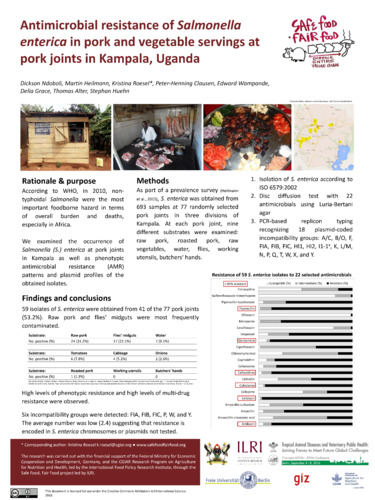Antimicrobial resistance of Salmonella enterica in pork and vegetable servings at pork joints in Kampala, Uganda
Abstract
The aim of this study was to investigate the prevalence and antimicrobial resistance
of Salmonella enterica subsp. enterica serovars including the presence of shared
plasmids in pork and related fresh vegetables served in pork joints in Kampala,
Uganda. Pork butcheries in three of the five administrative divisions of Kampala were
included for the survey. Samples included raw pork, roasted pork, water, onions,
tomatoes, cabbage, butcher’s hands (swabs), utensils (swabs) and fly midgut
extracts. A total of 693 samples were collected from 77 pork butcheries from June-
October 2014.
Overall 53.2% pork joints had samples positive for Salmonella enterica subsp.
enterica serovars. Isolation rates ranged from 31.2% (24/77) for raw pork, 1.3%
(1/77) for roasted pork, 7.8% (6/77) for tomatoes, 2.6% (2/77) for onions, 5.2% (4/77)
for cabbage, 9.1% (7/77) in water, and 22.1% (17/77) from fly midguts. Swab
samples taken from utensil and butcher’s hands swabs were found negative
(Heilmann et al., 2015).
In the isolates obtained, resistance towards 22 antibiotics was tested. Resistances
were found towards 11 out of the 22 antibiotics tested. High resistances were found
to Cephazolin (97%), Cefotixime (93%), Gentamicin (88%), and Ceftazidime (86%).
Intermediate resistance was found to Ciprofloxacin (59%) and Amoxicillin-Clavulanic
acid (57.6%). Most isolates (85%) were susceptible to Levofloxacin, Ofloxacin,
Sulfamethoxazole and Trimethoprim. Identification of plasmids by PCR-based
replicon typing was performed recognizing FIA,FIB,FIC,HI1,HI2,I1-
1ᵞ,L/M,N,P,W,T,A/C,K,B/O,X,Y,F and FIIA. Six incompatibility groups were identified:
FIA, W, FIC, FIB, P, Y with more than one incompatibility group existing among
different isolates.
A high resistance rate among Salmonella strains was found while the total number of
incompatibility groups detected was with approximation 2.4. Thus, even though the
total number of plasmids per strain is low, resistance rates detected remain high. The
high resistance rates are probably resulting from intensified food animal production
driving a greater use of antibiotics, which is a crucial aspect of public health concern.

